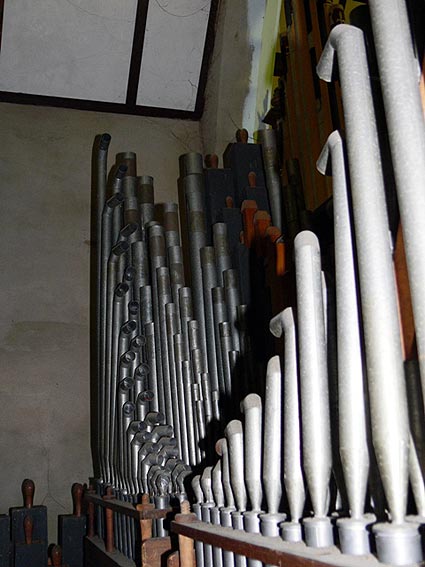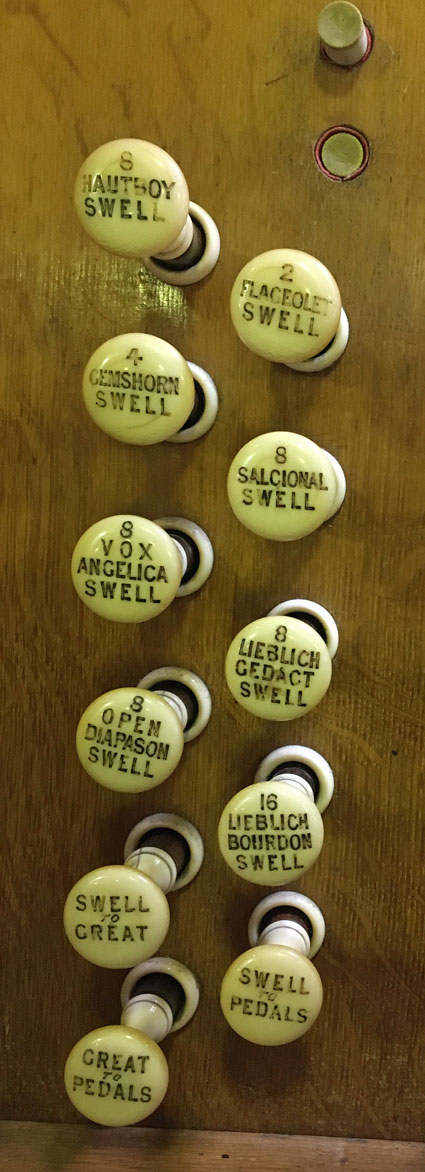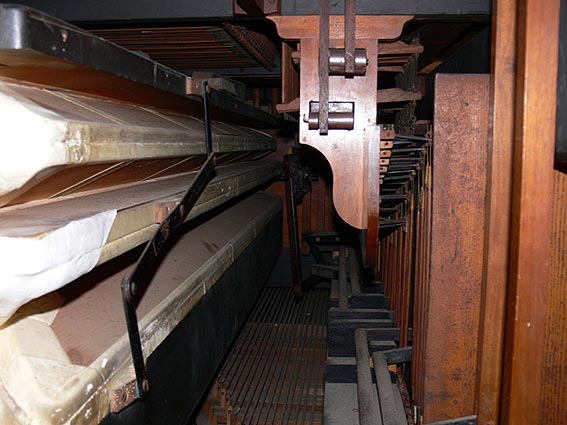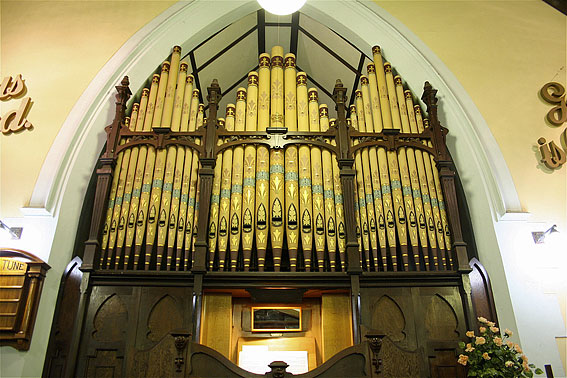Box Hill
Henry Willis 1877, London; inst.W.L. Roberts 1929 from "Findon", Kew
Res. 1969 Hill, Norman & Beard, and later by John Parker, Melbourne
Key actions res. 2010-2011 Wakeley Pipe Organs Pty Ltd.
2 manuals, 17 speaking stops, 3 couplers, mechanical action

The instrument was built in 1877 by the notable London organbuilder Henry Willis for the ballroom of 'Findon', Kew, the residence of The Hon. Henry Miller, a parliamentarian, and one of Victoria's wealthiest men. The place and date are recorded on one of the bellows ribs and the instrument unusually has a large brass plate bearing the builder's name (identical with the one supplied by Willis for the organ he built at Wentworth, South Yorkshire, in the same year). This was the only example of an organ exported by 'Father' Willis to Victoria and was a prestigious example of his work with turned solid ivory drawstops, thick ivory keys and immaculately finished internal components. It is likely that it was erected at 'Findon' by Robert Mackenzie as the local organbuilder George Fincham had not succeeded in delivering an earlier instrument ordered by Miller by the due date and it remained in Fincham's factory for some time before going to John Knox Presbyterian Church, Gardenvale.
Through the courtesy of Dr David Wyld, Managing Director of Henry Willis & Sons Ltd, we have copies of two schemes submitted to the Hon. Henry Miller for the organ at 'Findon', Kew, Victoria:


Estimate one
Specification of a Chamber Organ for The Honable Henry Miller Melbourne
To consist of two complete manuals from CC to A 58 notes and Two & a half Octaves of Pedals from CCC to F 30 notes
| Great Organ 1. Open Diapason 2. Lieblich Gedact 3. Claribel Flute 4. Dulciana 5. Harmonic Flute 6. Principal 7. Twelfth 8. Fifteenth 9. Clarionet Swell 10. Bourdon 11. Open Diapason 12. Lieblich Gedact 13. Salcional 14. Vox Angelica 15. Gemshorn 16. Harmonic Piccolo 17. Oboe 18. Horn Pedale 19. Bourdon 20. Flute 21. Swell to Great Coupler 22. Swell to Pedals " " 23. Great to Pedals " " |
8 feet 8 " 8 " 8 " 4 " 4 " 3 " 2 " 8 " 16 " 8 " 8 " 8 " 8 " 4 " 2 " 8 " 8 " 16 " 8 " |
bass derived from No2 (undulating to Tenor C bass No 13) (closed bass) |
Three Composition Pedals to Great Organ
Two Composition Pedals to Swell Organ
The Case to be of Oak or Mahogany of a design in Gothic with speaking pipes in front illuminated in Gold and Color the decoration of these pipes may be more or less costly according to the design and therefore this decoration not now forms any part of this contract.
The bellows to be of ample dimentions [sic] with double feeders inverted ribs etc. etc.
The Keys to be of thick Solid Ivory as in the finest Organs with black ebony sharps, bushings of cloth oval pins etc. etc.
The whole of the Metal pipes down to 4ft to be made of fine spotted metal, all pipes to be made in suitable thicknesses to enable them to encounter the long journey.
The roller-boards to be of Iron bushed, black varnished, in finest manner.
The whole to be constructed of finely seasoned suitable materials with the best possible workmanship and to be beautifully voiced and finished in the Factory, ready for inspection for the net sum of Seven hundred and Seventy-five pounds cash upon completion.
The packing cases will be charged for as usual by measurement.
The packing of the Organ and its carriage to the Docks in London will cost £15.
Pro Henry Willis
Henry J. Snelgrove
Rotunda Organ Works
Rochester Place
Camden Town
London N.W.
P.S.
This Organ can be built if the metal pipes to 4 feet C are made of plain metal instead of fine spotted metal (the larger pipes remaining the same, viz. of Zinc) also with a plain deal case stained and varnished instead of the more costly one of Oak or Mahogany for the sum of Six-hundred and forty-five pounds.
The decoration of the Front pipes may cost from Eighteen to Thirty pounds according to the design chosen.
The Pedal clavier unless otherwise ordered would be concave and radiating.
[Estimate book, pp.132-133]

Estimate two
Specification of a Chamber Organ for The Honble Henry Miller Melbourne
To consist of Two manuals from CC to A 58 notes And Two octave & a half of concave & radiating Pedals from CCC to F 30 notes
| Great Organ 1. Open Diapason 2. Dulciana 3. Claribel Flute 4. Flûte Harmonique 5. Principal 6. Fifteenth 7. Corno di Bassetto Swell 8. Open Diapason 9. Lieblich Gedact 10. Salcional 11. Vox Angelica 12. Gemshorn 13. Flageolet 14. Cornopean Pedale 15. Open Diapason 16. Bourdon Couplers 17. Swell to Great 18. Swell to Pedals 19. Great to Pedals |
58 pipes 58 " 58 " 58 " 58 " 58 " 58 " 58 " 58 " 58 " 46 " 58 " 58 " 58 " 30 " 30 " |
8 feet 8 " 8 " 4 " 4 " 2 " 8 " 8 " 8 " 8 " 8 " 4 " 2 " 8 " 16 " 16 " |
closed bass (Clarinet) (Tenor C bass derived) wood wood |
3 composition Pedals to Great Organ
The necessary case work of this Organ to be Deal stained & varnished with speaking pipes on front of plain Zinc metal.
The whole of the Metal pipes down to 4 feet to be made of fine spotted metal all below this to be of Zinc.
The bellows to be of ample dimentions [sic] with double inverted ribs, etc.
The Swell box to be framed and double lined, sawdust intervening
Concussion valves attached to Great & Swell
The roller boards to be of Iron bushed, etc.
The whole Organ to be artistically built from suitable finely seasoned materials with finest description of workmanship, and beautifully voiced and finished in the factory ready for inspection for the net sum of six hundred and five pounds cash upon approval, then to be taken down and packed and delivered to the Docks in London for a further Sum of Twelve pounds, this sum will not include the cost of the packing which will be charged for as usual by measurement.
| A.K. Sheppard Esqr. Bank of Victoria 3 Threadneedle Street E.C. London |
Pro Henry Willis Henry Snelgrove Rotunda Organ Works Rochester Place Camden Town |
[Estimate book, p. 133]

In the final result, the organ that was built was a conflation of the two above schemes, and has the following specification:
| GREAT ORGAN Open Diapason Claribel Flute Dulciana Principal Flûte Harmonique Fifteenth Corno di Bassetto Swell to Great SWELL ORGAN Lieblich Bourdon Open Diapason Lieblich Gedact Salcional Vox Angelica TC Gemshorn Flageolet Hautboy PEDAL ORGAN Bourdon Pedale Flute Pedale Great to Pedals Swell to Pedals |
8 8 8 4 4 2 8 16 8 8 8 8 4 2 8 16 8 |
Compass: 58/30
3 composition pedals to Great
2 composition pedals to Swell
balanced swell pedal (originally lever pedal)
attached oak console with solid ivory drawstops
all metal pipework above 4ft of spotted metal
hand blowing available
concussion bellows fitted to Great and Swell windchests
The organ and the mansion 'Findon' was shown in the massive 1888 work Victoria and Its Metropolis.
After 1900 it was moved to another Miller mansion 'Whernside', in Toorak, where the central pipe on the facade may have been slightly cut down for a reduced ceiling height. In 1929 it was moved to its present location at the Methodist Church, Box Hill and was installed by W.L. Roberts at a cost of £650. It remains unaltered apart from the introduction of electric blowing, tuning slides, a balanced swell pedal and a swell tremulant. Classified by the National Trust of Australia (Victoria) as a significant organ, there are currently plans for a careful restoration. Earlier restoration work has been carried out by Hill, Norman & Beard in 1969 and later by John Parker, Melbourne. The mechanical key actions and concussion bellows were fully restored by Wakeley Pipe Organs Pty Ltd in 2010-2011 assisted by an OHTA appeal.
 |
 |
 |
 |
 |
 |
 |
Photos: JRM


Dr Gordon Atkinson demonstrating the organ


Sam Allchurch playing



Photos above: Trevor Bunning (Oct. 2008)